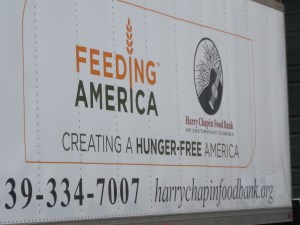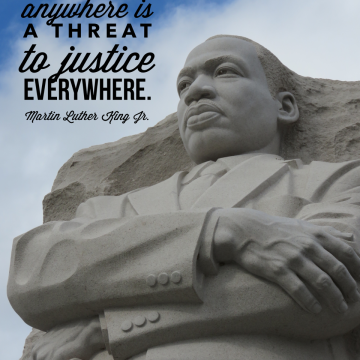
When was the last time you went to a food bank? Well, I have to admit that I don’t do it often enough. The morning after one of our conferences, several friends and I, all members of the Ag Relations Council, spent several hours at the Harry Chapin Food Bank in Fort Myers, Florida. Its taken me far longer to get this blog post up, but I kept thinking I didn’t want to short-change the food bank.
Understanding Need in Southwest Florida
This was the first time I’d flown into Fort Myers. I was there for a conference but most of the people on the plane were heading down on vacation. The area draws tourists for Major League Baseball spring training camps, fishing expeditions, beautiful beaches and more. And while the area may have a lavish appearance to tourists, hunger has a home everywhere.
The food bank’s website does a great job explaining the situation:
The current economic environment has resulted in an increased number of those in need of emergency food. Most of these increases are directly attributable to the housing slump and the corresponding surge in unemployment. In fact, Lee County has been cited in the New York Times and elsewhere as the hardest hit of any U.S. county by the housing/mortgage crisis. According to a recent article by CNN.com/US (2009, February 23), Lee County, Florida, is one of the hardest-hit areas in the country and presents a microcosm of the national housing dilemma. With home prices down about 50 percent from their peak and unemployment now at 10 percent, the area is littered with “For Sale” and “Auction” signs. The increase in demand has been accompanied by a significant shift in the demographic profile of those being served by the emergency food system. The emergency food programs are seeing more and more families that have never previously had to ask for charitable assistance. The impact of the economy on livable wage construction jobs has been devastating. More and more of these families, many of whom were food drive donors in the past, are being forced to ask for aid.
via Harry Chapin Food Bank – About the Food Bank – | Emergency Food Suppliers | Feeding SW Florida.
Fresh Food for the Hungry

When we volunteered to spend several hours there, I pictured us doing something like sorting canned foods onto shelves or packing boxes or something. I didn’t picture us going through huge bins of bell peppers sorting bad out and packaging good into manageable bags. But then I guess the beauty of being surrounded by all the great fresh vegetables is that there could be some available for charity too.
So I had the chance to learn a lot! For instance:
- Some of the farmers who produce fruits and vegetables in Florida are willing to donate the products they grow, particularly knowing Americans are provided a cosmetically pleasing product in the markets. So, what happens to some of the smaller fruits and vegetables or things that aren’t perfectly shaped?
- The Harry Chapin Food Bank has worked with vegetable packers to, wherever possible, have the packers harvest crops or parts of crops that may not be marketable and segment them off for the food bank.
- Field crops in Florida where the packer doesn’t do this are sometimes available for gleaning. The process of gleaning is difficult for several reasons: 1) heat, 2) strenuous demands of harvest, 3) need for farmers to move to the next crop quickly.
- There are some places where farmers donate an acre worth of food to the local food bank. They tend it like the rest of the crop & let volunteers like the American Farm Bureau harvest for food banks.
We got a tour of the facility and then got pointers on our job — sorting through produce that mad been delivered in huge bins. We pulled the good ones out and put them in small bags for delivery to people. I could see stuffed peppers, spaghetti sauces and more being cooked up in some of these places!
This video below will give you a better feel for the day. And I’d love to hear whether you’ve taken chances to do similar projects at food banks.
[youtube=https://www.youtube.com/watch?v=fCW-l1YNd3A]



Our youth went to a Salvation Army or Goodwill site where the donations were all processed. We put clothing in a huge “baler” that compressed it and secured it , I think with wire, then the bales were shipped oversees. We had to sort barrels and barrels of shoes into wearable pairs, We stacked and sorted alot of other stuff too. It was part of the day during a Christian youth get together and a wonderful addition to our day. I wish I could remember which agency, but alas, it was years ago and I don’t.
The rush I get from doing this sort of thing is pretty common since we get to step back and think about helping feed & clothe others, but I like the direct involvement. Will find more opportunities to be involved.
This is just an awesome blog post!
Thanks so much Cheri! I was really pumped that we got to work with fresh foods and make a difference.
At DollarSeed.com https://t.co/aKCz8ND4 We take pride in sharing our profits with pantry growers throughout the year all over the US. We pick those groups who we feel will make a big difference in their communities, and supply them with seeds to grow fresh produce. One such group known as GreenRacine in Wisconsin is now on their second year of receiving our support. We chose to do a second round, because this is a down trodden township with no local Supermarkets, High Unemployment, and many people who are forced to go without do to lack of transportation. Typically we pick 5 or 6 groups to support per year. At the end of each growing season we send all of our leftover seed stock to the Cornell Cooperative Extension’s Outreach Program, which teaches school age children throughout NY sustainable gardening.